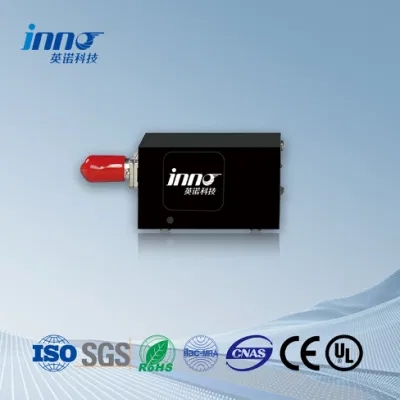
ほとんどすべての材料は、適切な条件下で蛍光を示します. 蛍光は、材料が電磁放射にさらされたときの発光として簡潔に定義できます. 最初の励起後, この放出は、一定期間持続する可能性があります. この期間は、原子レベルで起こる多数の相互作用と吸収されたエネルギー量の産物です. 励起強度と発光強度はどちらも、時間の経過とともに指数関数的に変化します. この二重の時間依存的な振る舞いは、蛍光物質分子の状態を示すために利用できるユニークな性質です.
科学者たちは、特定の元素をドープして、その挙動を特定の物理的特性に大きく依存させることができるさまざまな種類の蛍光物質を発見しました, センシング用途で実用上重要な意味を持つ. 例えば, 特定の結晶マトリックスの蛍光特性を使用して温度を測定できることがわかりました, 圧力, 湿度, 酸素, と二酸化炭素. これらすべての物理的特性は、独自の蛍光材料の指数関数的な時定数を正確に決定することによって測定できます. これらの原理を利用した一連の費用対効果の高い光ファイバー温度センサーが開発されました. 競合するセンシング技術に対する光ファイバーセンサーの注目すべき利点は、電磁ノイズや干渉に対する固有の耐性です, 電流と電圧を送信するアンテナとして機能する金属導体がないため、. これにより、蛍光光ファイバーセンサーは、高電圧送電のアプリケーションに特に適しています, マイクロ波, およびプラズマ環境. かつ, 光ファイバー温度測定技術により、150°C未満の用途で安価な大芯ポリマープラスチック繊維を使用できます. これらのプラスチック繊維は、非常に堅牢で耐久性があります, 自動車で広く使用されています, インダストリアル, 電気通信部門.
光ファイバ温度センサソリューション
光ファイバ温度センサは、温度トランスミッタと呼ばれる電子機器に接続された1つ以上の光ファイバプローブで構成されています (シグナルコンディショナとも呼ばれます). マルチチャンネル光ファイバ温度センサは、送電や配電などの用途向けに開発されました. 従来の光ファイバー温度伝送器との違い, かさばり、高価な実験装置でした, 光ファイバ信号変換器は、熱電対またはRTDと外観と設置が似ています (測温抵抗体) トランスミッタ. レールに取り付けられたDINで、標準の4-20mAアナログ出力を備えています, また、産業用RS-485シリアルバスMODBUSによるデイジーチェーンデバイス通信. 蛍光光ファイバー温度センサーの光学プローブも、標準的な熱電対やRTDと同様の外観と感触を共有しています. 光ファイバ温度センサのコストは、市販のRTDとトランスミッタの組み合わせに匹敵します.
光ファイバーセンサーの精度と安定性は、従来の熱電対を上回り、PRTに近づくことができます (白金測温抵抗体) 校正用途. ±1°Cの長期安定性を備えたソリューションが利用可能です, 絶対精度±0.1°Cの製品.
変圧器巻線ホットスポット温度監視
光ファイバー温度センサー, EMI/RFIや高電圧環境の影響を全く受けない, 変圧器巻線のホットスポットを監視するのに理想的な選択肢です. 正確, リアルタイム, インテリジェントグリッド温度監視ソリューションは、電力および配電機器向けに開発されました.
光ファイバ温度センサは、高電圧乾式変圧器温度測定の優れたソリューションであることが証明されており、現在では変圧器監視の好ましい方法と見なされています. 光ファイバーセンサーが送配電にもたらす利点 (T&D) 企業は経済的に重要です. 各変圧器巻線ホットスポットの温度を監視する, 公益事業会社は、変圧器の寿命を大幅に縮める可能性のある過負荷状態に陥ることなく、乾式変圧器をピーク容量で運転できます. この伝送スループットと寿命の効率化により、毎年かなりの資金を節約できます, 直巻温度対応が必要.
費用対効果の高い光ファイバー温度センシング技術により、インテリジェントグリッド変圧器の温度監視がより魅力的になります. 光ファイバー温度プローブは、高絶縁耐力材料で設計されています, PTFEやポリイミドコーティングされた石英繊維など, そのため、製造プロセス中の変圧器油や灯油の脱着に長期間浸漬しても耐えることができます. 特殊な光学温度トランスミッタを使用した光ファイバセンサは、変圧器巻線のホットスポット位置に直接設置されたプローブに信号を送信します. 光ファイバ温度伝送器は、外部制御キャビネットに取り付けられています, 温度出力はリアルタイム監視ソフトウェアに入力されます. 光学式温度センサーを取り付けた状態, オペレーターはリアルタイムで負荷を監視できます,
開閉装置温度監視
経済的な光ファイバー温度センサは、連続的な, 重要な接点における開閉装置温度のリアルタイム監視, 過負荷と障害の迅速な検出が可能. 温度伝送器は、アナログ出力とRS-485 Modbus通信を提供します, 既存のPLCと簡単に統合できます (プログラマブル・ロジック・コントローラ) およびマスター監視ソフトウェア. 光学式温度センサは、長年の高精度センシングを提供します, 安全で効率的な開閉装置操作の確保.
世界中のパワー開閉装置メーカーは、重要な媒体や高電圧開閉装置のスマートグリッド温度監視に光ファイバーセンサーを使用しています. これらのセンサーは、リアルタイムの温度データを提供します, オペレータは負荷効率を最大化し、壊滅的な故障につながる可能性のある熱応力のバランスをとることができます. 時間の経過とともに, 開閉装置の接点, バスバー, また、重要な接続ポイントでは、ホットスポットが徐々に腐食していきます, その結果、抵抗が増加します. チェックを外すと, 抵抗がわずかに増加しただけでも、すぐに制御不能になる可能性があります, 抵抗値が高いほど導体が高温になります, これにより、より高い抵抗が生成されます. そこで, T&D社は、メンテナンススケジュールを最適化し、機器の寿命を延ばすために、開閉装置の温度を継続的に監視する要件を指定することがよくあります.
しかし, 課題の1つは、高電圧センシングアプリケーション向けの費用対効果の高い技術を見つけることです. 各種RF (無線周波数) ワイヤレスおよびIR (赤外) 温度計が使用されています, しかし、それぞれに欠点があります. RFトランスミッタ/レシーバセンサは、高電圧環境に存在する固有のノイズと干渉の影響を受け、スイッチ動作中に信号が失われたり、温度スパイクが表示されたりする可能性があります, これは誤警報につながる可能性があります. さらに, これらのセンサーは電子部品を使用しているため, それらの温度範囲は通常、長期間の使用のために120°C未満に制限されています. リモート赤外線温度センサーも同様です, ワイヤのシールドと特別な設置ポイントが必要なため, 感知される物体の表面との正確な空間的アライメント. 赤外線温度計は、ほこりの蓄積による温度変化や、わずかな表面腐食によって引き起こされる放射率の変化を報告することが知られています, 特に銅のバスバーのような明るい金属表面では. 報告された温度は、周囲の物体から反射された赤外線エネルギーによって歪められる可能性があります, また、周囲温度の急激な変化も測定誤差の原因となります.
光ファイバー温度センサは、ワイヤレスおよび赤外線温度計に関連する技術的な課題に遭遇しません. 光ファイバセンサは、重要な開閉装置監視ポイントに直接配線できます. 光学式温度センサは、ホットスポットの位置にしっかりと接続されており、高電圧スイッチによる電磁干渉やノイズバーストの影響をまったく受けません. 光ファイバセンサは堅牢で耐久性があります, さまざまな長さで製造できます, 従来の熱電対のように機能します. 最も重要なこと, 各光学式温度センサー送信機は、3つのフェーズを監視できます, アナログ出力とデジタルRS-485 Modbus RTU通信を提供. 光ファイバー温度プローブは、スマートグリッドスイッチギアの温度監視に非常に適しています.
発電機巻線温度監視
今, オンライン光ファイバー温度監視は、低電圧と高電圧の両方の発電機機器で一般的です. 光ファイバーセンサーは、リアルタイムの温度監視のための経済的で効率的なソリューションを提供します, 機器が最適なパフォーマンスで動作し、寿命を延ばすことができます.
光ファイバー温度センサーは、現在、大型のモーターおよび発電機機器に一般的に設置されており、重要なステーター巻線とベアリングのリアルタイム監視と熱保護を提供します. 回転機械の巻線の安全な動作温度は、断熱材が最終的に劣化する前に耐えられる熱量によって制限されます. この温度と劣化速度は、断熱材のカテゴリによって異なります. 特定の温度での断熱劣化は、温度が臨界しきい値を超える時間の長さにほぼ比例します. 最近まで, RTDの (測温抵抗体) 通常、巻線に埋め込まれて、継続的な監視を提供していました, EMI/RFI干渉による不正確さは存在しましたが. 今, 経済的な光ファイバー温度センサーは、高電圧と交流電磁界が従来のRTD巻線センサーの問題を引き起こす場所に設置できます. モーターと発電機の巻線の間に光ファイバーセンサーを挿入して、連続的な温度測定を行い、断熱材を保護し、メンテナンススケジュールを延長することができます. 光学式温度センサーを設置する, オペレーターは、負荷をリアルタイムで監視し、エネルギーと経済効率を最大化できます. エネルギー効率の向上は、ビジネスにとっても環境にとっても有益です.
MRI温度モニタリング
さまざまなライフサイエンスおよび患者モニタリングアプリケーションには、高精度の光ファイバー温度センシングが必要です. MRIには、シングルチャネルおよびマルチチャネルの光ファイバー温度プローブが用意されています (磁気共鳴画像法), NMRの (核磁気共鳴画像法), およびRF (無線周波数) 環境, 高速応答と優れた精度を備えた低コストの使い捨て温度プローブを含む.
さまざまなライフサイエンスアプリケーションは、標準的な温度計やRTDには不利な環境での高精度センシングのために、光ファイバー温度センサに依存しています (測温抵抗体). 光ファイバーセンサーの用途の1つはMRIです, NMRIの, 患者モニタリングのためのMRT環境, 非常に高い磁場とパルスRFが組み合わされた場合 (無線周波数) エネルギーは金属センサーの使用を禁止しています. OSENSAの光ファイバーセンサーは非金属材料でできており、患者の体温を監視して、組織の比吸収率が破壊レベルを超えないようにするのに非常に適しています. 光ファイバ温度センサは、超電導磁石の低温冷却の監視にも使用できます.
さまざまなサイズと材料のさまざまな高精度光ファイバー温度センサーが利用可能です, MRIやCTに最適 (X線コンピュータ断層撮影) 勉強. 光ファイバープローブは、X線透過性材料と非磁性コネクタでできています, MRIおよびCTスキャンルームに完全対応. さらに, 迅速な対応, 超小径光ファイバープローブをご用意しております, 多くの要求の厳しいアプリケーションの要件を満たすように設計されています.
半導体チャックの温度とプロセス制御
高精度光ファイバ温度センサは、半導体プロセス制御アプリケーションの厳しい要件を満たすように設計されています. 誘電体および導体エッチングアプリケーション向けの迅速な応答を提供するカスタムOEMソリューションは、接触式および非接触式の両方の光学温度センシングに提供されます. 光ファイバーセンサーは、静電チャックの複数のゾーンに埋め込まれており、最大限の制御と熱均一性を提供します.
Many semiconductor wafer processing applications rely on fiber optic temperature sensors for precise process control in high RF (無線周波数) およびプラズマ環境. 一般的な処理アプリケーション, シリコンウェーハは、プラズマ環境内で急速に加熱および冷却される静電チャック上に置かれます. 光ファイバー温度センサーは、静電チャックのベースに埋め込まれています, 高精度と迅速な応答を提供し、厳格なプロセス制御を実現. 各静電チャックは複数のゾーンに分かれています, ウェーハ表面全体の温度均一性を最大化するために、複数の光ファイバー温度センサーが必要. 通常、このタイプのセットアップを採用する半導体アプリケーションは、誘電体および導体エッチングプロセスです.
プラズマ化学気相成長の強化 (EPCVDの) プロセス, シャワーヘッドリアクターは、強力なRFパワーを印加しながら、反応ガスを処理チャンバー全体に分散させるために使用されます. これらのアプリケーションでは, 光ファイバー温度センサーは、シャワーヘッドの温度を制御し、側壁の温度を監視して、チャンバー表面への堆積を最小限に抑えるために使用されます. 光ファイバ温度センサは、さまざまな最先端の半導体プロセスをサポートするために開発されました. センサーは非接触の幾何学的構造を特徴としています, 静電チャックの基部にセンシング材料を埋め込んだもの, 光ファイバーはリモートに配置されています. この方法により、応答時間が最大化され、ステム伝導損失がなくなります. また、電子コレットの交換と改修も簡素化されます.
マイクロ波および誘導加熱制御
マルチチャネル光ファイバー温度センサは、産業用マイクロ波プロセスの温度監視に経済的で便利なソリューションを提供します, マイクロ波支援化学を含む, マイクロ波滅菌, およびマイクロ波焼結. マイクロ波環境用の光学式温度プローブは、化学的および生物学的適合性を最大限に高める材料で構成されています, または、堅牢なステンレス鋼と高温セラミックから.
光ファイバー温度センサーは、マイクロ波放射と高周波電磁界に対して本質的に免疫があります. 光ファイバー温度センサを使用するマイクロ波環境には、食品加工および乾燥用の産業用電子レンジが含まれます, ガラス溶解用マイクロ波窯, そして紙を乾燥させるため, 繊維, または木材. その他の用途には、セラミックスや歯科用器具のマイクロ波焼結が含まれます, マイクロ波滅菌, と電子レンジ害虫駆除.
開発された光ファイバー温度プローブは、さまざまな産業用電子レンジおよび窯のアプリケーション向けにカスタマイズできます. また、この技術により、短距離の非接触光学式温度測定が可能になり、非常に高い閾値を超える温度を測定できます.
誘導加熱器と炉は、高出力の交流電磁場を使用して、導電性物体を急速に加熱します. 例としては、射出成形装置へのバレルおよびインモールド誘導加熱の使用があります. これらのヒーターは、 5 100kHzまでで、 10 40kWまで. 産業グレードの光ファイバ温度センサは、強い電磁エネルギーに対する堅牢性を備えているため、これらのアプリケーションに特に適しています, 高い信頼性, 迅速な応答時間. マルチチャンネル温度伝送器 (信号コンディショナ) 4-20mAのアナログ出力により、射出成形プロセス制御装置に簡単に統合できます.
研究・教育用光ファイバ温度センサ
高精度の光ファイバー温度センシングソリューションを必要とする研究開発活動. ソフトウェアおよび光ファイバープローブは、さまざまなラボおよびテストアプリケーション向けにカスタマイズおよび校正できます. 光ファイバー温度センサは、強い電磁界に対する耐性があるため、研究用途によく選択されます, 核, およびX線放射. その柔軟性と使いやすさにより, 光ファイバーセンサーは、研究アプリケーションに最適です. ソフトウェアをインストールしてUSBケーブルを接続するだけで、温度の光学監視を開始できます. アプリケーションサポートエンジニアがフレンドリーなサポートを提供します, そして、より要求の厳しいアプリケーションのために, エンジニアリングコンサルティングサービスを提供できます.
光ファイバー温度センサーは、学生の実験室での作業にも非常に適しており、物理学の教師にユニークな教育活動を提供します, 化学, 生物学, 電子工学, および計装. 高度なソフトウェアにより、低コストで簡単な温度ロギングとキャリブレーションが可能.
光ファイバー温度センサ, インテリジェント監視システム, 中国の分散型光ファイバーメーカー
 |
 |
 |
 INNO光ファイバー温度センサー ,温度監視システム.
INNO光ファイバー温度センサー ,温度監視システム.
